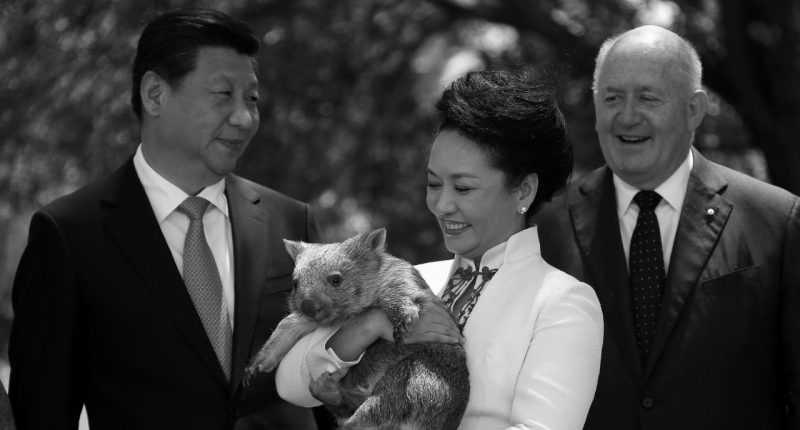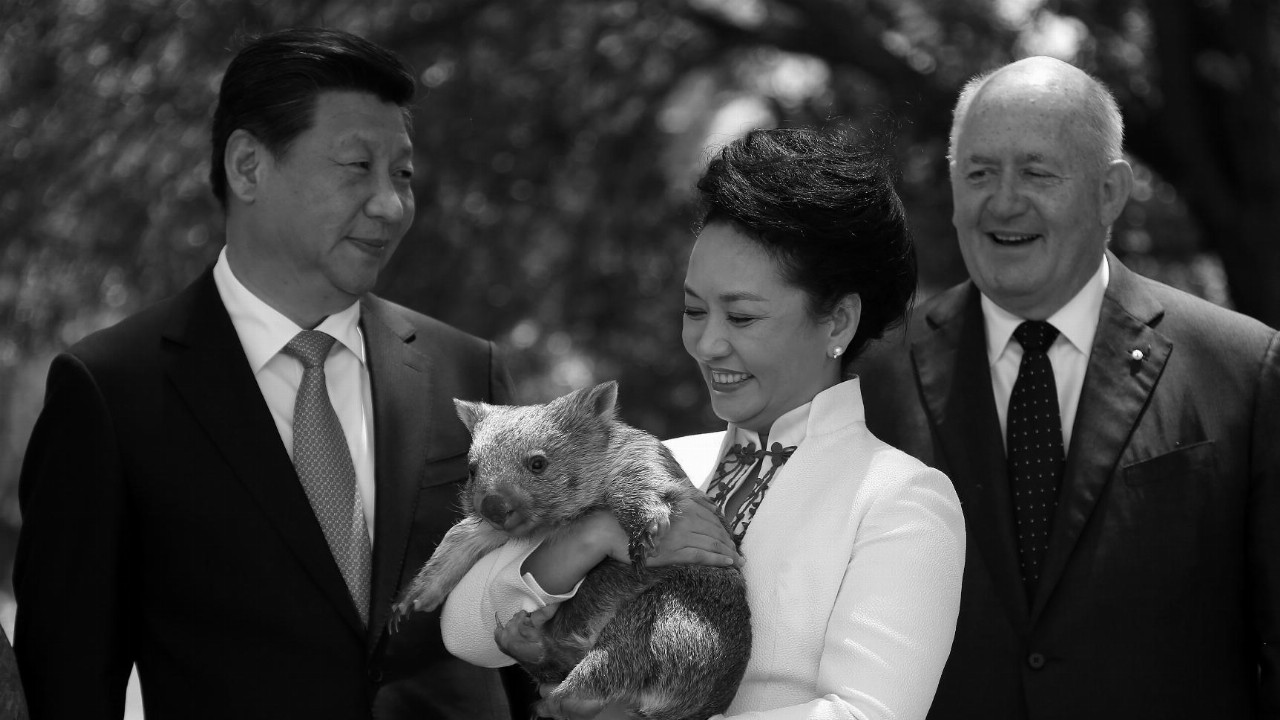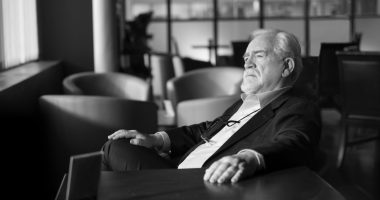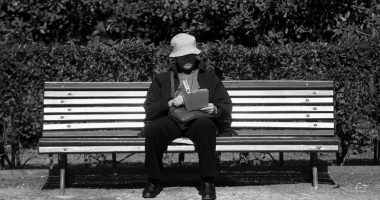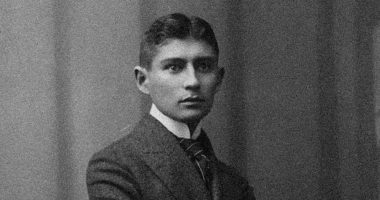In 2014, not so long ago, Chinese President Xi Jinping stood for photos with blonde schoolchildren in the mild, dappled Tasmanian sunshine. He had a shovel in his hand, a wry smile on his face, planting a tree in a large Chinese-style terracotta pot. At that time, things were flying high between the two countries. Only earlier, he had posed for photos (that same smile) with First Lady Peng Liyuan holding a koala. The president would culminate his trip speaking about “a new relationship” in front of Tony Abbott’s Coalition parliament, to rapturous bipartisan applause that echoed up through the gallery. Xi shook Bronwyn Bishop’s hand, eight years ago, in what now seems like a parallel universe.
At the time, the two countries enjoyed the benefits of a mining boom followed by an investment glut, and partnerships developed into lucrative arrangements with private and public entities. The relationship between Beijing and Canberra had never been more substantial, and for what it was worth, primarily based on mutual interest. Although, it wasn’t as if this relationship had appeared out of thin air. For around two centuries, the relationship between China and Australia has been significant, and worth considering in Canberra’s calculations regarding its role in the developing great power confrontation between our largest military and trading partners.
The modern beginnings of Australia, always connected to Asia, has a history interwoven with China. In the 1800s, the Victorian township of Ararat was founded by Chinese immigrants, an example of the area steeped in the legacy of eastern gold prospectors that defined the Victorian diaspora. From the early days of urbanisation, Chinese immigrants played an integral part in the identity of Australian life as one of the many ethnic communities providing the cultural staples that padded a nest for a country looking to find its own. Today, Chinese Australians make up an integral element of our major capitals, helping to define the lifestyle we like to promote in competitions for “most livable city”.
Somewhere in that melting pot the dim-sim was invented by a business savvy Chinese Australian in the 1940s, unique to this country, and nowhere else. From William Creek to Hobart, Australia had its own connection to China. By the 1960s, Australian wheat farmers worked with Country Party leader John McEwen, defying US orders and some in his own Coalition, to ship grain into famine-stricken China. Throughout the decade, McEwen was steadfast in his view that “trade between Australia and China would benefit the people of both countries”. And perhaps he wanted to save a few lives as well.
As Leader of the Opposition, Gough Whitlam went to China in 1971 and laid the foundations for a future relationship. In 1973, as Prime Minister, Gough became one of the first Western leaders to normalise relations with China, beating Nixon to the punch. For the next half a century, the relationship between the two countries developed a continuity of political acceptance and mutual understanding that became reliable and stable. That stability allowed for the foundations of a trade relationship that was the envy of many countries around the globe. Australians first took the Chinese to Antarctica in the eighties, helped to improve healthcare across poorer cities and towns in the nineties, while working in collaborative ventures to improve diplomatic relations.
By the 2000s, Australia was set on autopilot from the income generated by a continuous stream of resources being purchased primarily by Beijing. As the world heaved under the GFC, collapsing global economies and closing massive financial institutions resulted in austerity, bankruptcy and Arab Springs, Australia glided safely in the wake of seven to 10 per cent GDP growth, against the grain, by Beijing. A record export iron ore price, coinciding with huge Chinese consumer demand for Australian products meant that, by and large, Australia missed out on the GFC backlash of catastrophic property market collapses and a global economic crash, still being felt in many countries.
The Port of Darwin lease was the textbook example of no-holds-barred cooperation that ran alongside unlimited dreams of wealth and opportunity, supported by the love affair of the Australian political and business classes with the lucrative allure of Chinese markets. Along with increases in Chinese foreign investment into Australian capital, exporters looked to capitalise upon untapped markets in the massive Chinese middle class, while Australian manufacturers expanded their capacity and wealth in the cheap, high quality Chinese factories. Our industrial class sacrificed thousands of Australian jobs to the mega factories of Guangdong and the steelworks of Hebei.
The casinos flew in Chinese high rollers 24/7, the mayors of capital cities celebrated Chinese New Year, joint military exercises were held in Sydney Harbour, and Confucian institutes were proudly supported by our universities. The entire country — from mining and energy, agriculture, property, the university sector, and both sides of parliament — was vying for Chinese fortune.
Not too long ago, Xi Jinping was cuddling koalas in Tasmania and wearing Carlton scarves with John Brumby. Today, a relatively short period later, Canberra is fusing its strategic future to the circuitry of a new cold war, choosing sides against a rising superpower at the behest of another.
The newly housed nuclear capable B-52s at Tindal add to the US marines stationed in Darwin, the significant intelligence collection points in Pine Gap and Exmouth, and to the submarines and the uncertainty of AUKUS. So where do we go from here?
Under the pressure of external tensions, decision makers seem to be looking at the stark points of difference, and increasingly adopting Washington’s perception of “shared values and commitments to a peaceful and prosperous Indo-Pacific”. This can act in difference to the undeniable mutual benefits between our countries, the economic complexities unique to the relationship, and the meaningful history of nuanced diplomacy between the two nations.
To have any chance of peaceful co-existence, both China and Australia must store their demands and ideology for later consideration, while working hard on common ground, building trust in matters of mutual benefit. Whatever Xi meant as he lifted his shovel from the barrow, the adoration, the koalas, and the handshakes with Bronwyn Bishop would not come to mean the same thing — it may have been that the applause only seemed to ring for the endless streams of Chinese money that was flowing through Canberra. Now that the applause has been drowned out by jeers, the relatively new Albanese Government must calm the crowd or risk taking this significant relationship into uncharted territory.
Throughout a complex relationship featuring periods of war and famine, disagreement and compromise, Canberra and Beijing have established a unique and tempered relationship based on clearly defined objectives and clearly stated differences.
At every point of Australia’s relationship with its Asian partners, for every agreement, tension, gain and diplomatic breakdown throughout our short modern history, residing underneath is a primordial societal flaw — a distrust of our Asian neighbours. Born in the eugenic-heavy decades of the early twentieth century, alone in a foreign region as the champions of white Anglo-Saxonism, the idea of ‘yellow peril’ was something we had no trouble adopting. We applied it to the ‘Chinese invasions’ in the gold rush, referring to the influx of mining labour from Asia, we then attached it to the Imperial Japanese war machine, and later, successfully projected it on to the Vietnamese, the Indonesian fishermen, and now maybe we are all the way back to the Chinese again. However, it’s not the same now.
Joel Jenkins is a writer and independent political analyst focused on the intersection of class, the state of the nation, and Australian independent policy.
